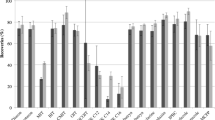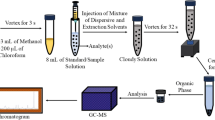Abstract
Gas chromatography/mass spectrometry (GC/MS) and enzyme-linked immunosorbent assay (ELISA) techniques were used to measure concentrations of dissolved atrazine in 149 surface-water samples. Samples were collected during May 1992–September 1993 near the mouth of the White River (Indiana) and in two small tributaries of the river. GC/MS was performed on a Hewlett-Packard 5971 AFootnote 1 with electron impact ionization and selected ion monitoring of filtered water samples extracted by C-18 solid phase extraction; ELISA was performed with a magnetic-particle-based assay with photometric analysis. ELISA results compared reasonably well to GC/MS measurements at concentrations below the Maximum Contaminant Level for drinking water set by the U.S. Environmental Protection Agency (3.0 μg/L), but a systematic negative bias was observed at higher concentrations. When higher concentration samples were diluted into the linear range of calibration, the relation improved. A slight positive bias was seen in all of the ELISA data compared to the GC/MS results, and the bias could be partially explained by correcting the ELISA data for cross reactivity with other triazine herbicides. The highest concentrations of atrazine were found during the first major runoff event after the atrazine was applied. Concentrations decreased throughout the rest of the sampling period even though large runoff events occurred during this time, indicating that most atrazine loading to surface waters in the study area occurs within a few weeks after application.
Similar content being viewed by others
Notes
Use of brand names is for identification purposes only and does not constitute endorsement by the U.S. Geological Survey, the Uniroyal Chemical Company, or Wichita State University.
References
Carter DS, Lydy MJ, Crawford CG (1995) Water-quality assessment of the White River Basin, Indiana: Analysis of available information on pesticides, 1972–92: U.S. Geological Survey Water-Resources Investigation Report 94-4024
Edwards TK, Glysson GD (1989) Field methods for measurement of fluvial sediment. U.S. Geological Survey Open-File Report 86-531
Eisler R (1989) Atrazine hazards to fish, wildlife and invertebrates: A synoptic review. Contaminant Hazard Review, Report No. 18, pp 1–5
Gianessi LP, Puffer CM (1991) Herbicide use in the United States: Resources for the future, p 27
Huber SJ (1985) Improved solid-phase enzyme immunoassay systems in the ppt range for atrazine in fresh water. Chemosphere 14:1795–1803
Indiana Agricultural Statistics Service (1993) Indiana agriculture report, v. 13, no. SP-5; Purdue University, West Lafayette, IN
Moody JA, Goolsby DA (1993) Spatial variability of triazine herbicides in the lower Mississippi River. Environ Sci Technol 27(10):2120–2126
Pereira NE, Rostad CE (1990) Occurrence, distribution and transport of herbicides and their degradation products in the lower Mississippi River and its tributaries. Environ Sci Technol 26:1400–1406
Rubio FM, Itak JA, Scutellaro AM, Selisker MY, Herzog DP (1991) Performance characteristics of a novel magnetic particle based ELISA for the quantitative analysis of atrazine and related triazines in water samples. Food and Agricul Immuno 3:113–125
Sandstrom MW, Wydoski DS, Schroder MP, Zamboni JL, Foreman WT (1992) Methods of analysis by the U.S. Geological Survey National Water Quality Laboratory—Determination of organonitrogen herbicides in water by solid-phase extraction and capillary-column gas chromatography/mass spectrometry with selected-ion monitoring. U.S. Geological Survey Open-File Report, 91-511, 26
Shelton LR (1994) Field guide for collecting and processing stream-water samples for the National Water-Quality Assessment Program. U.S. Geological Survey Open-File Report 94-455
Sokal RR, Rohlf FJ (1982) Biometry: The principles and practice of statistics in biological research, 2nd ed. W.H. Freeman, San Francisco, CA
Thurman EM, Meyer MT, Pomes ML, Perry CA, Schwab AP (1990) Enzyme-Linked Immunoassay compared with gas chromatography/mass spectrometry for the determination of triazine herbicides in water. Anal Chem 62:2043–2048
Thurman EM, Goolsby DA, Meyer MJ, Mills MS, Pomes ML, Kolpin DW (1992) A reconnaissance study of herbicides and their metabolites in surface water of the Midwestern United States using immunoassay and gas chromatography/mass spectrometry. Environ Sci Technol 26:2440–2447
Zaugg SD, Sandstrom MW, Smith SG, Fehlberg KM (1995) Methods of analysis by the U.S. Geological Survey National Water Quality Laboratory—Determination of pesticides in water by C-18 solid phase extraction and capillary-column gas chromatography/mass spectrometry with selected-ion monitoring. U.S. Geological Survey Open-File Report 95-181
Author information
Authors and Affiliations
Rights and permissions
About this article
Cite this article
Lydy, M.J., Carter, D.S. & Crawford, C.G. Comparison of gas chromatography/mass spectrometry and immunoassay techniques on concentrations of atrazine in storm runoff. Arch. Environ. Contam. Toxicol. 31, 378–385 (1996). https://doi.org/10.1007/BF00212676
Received:
Revised:
Issue Date:
DOI: https://doi.org/10.1007/BF00212676




